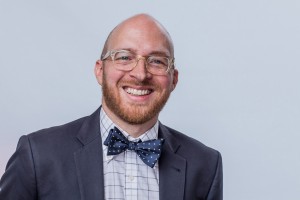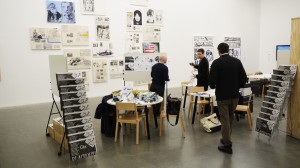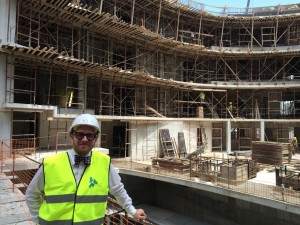 Daniel Payne graduated from BHP in 2002. After working in investment banking and financial services, he decided to change paths and pursue a Master of Architecture degree from Columbia University. He is now a consultant for AEA Consulting, one of the world’s leading arts, culture and entertainment consulting firms based in New York. Prior to joining AEA, he worked on exhibitions and installations that appeared in the New Museum, Center for Architecture, New York Fashion Week, PS1, Storm King Art Center and the galleries at Columbia University.
Daniel Payne graduated from BHP in 2002. After working in investment banking and financial services, he decided to change paths and pursue a Master of Architecture degree from Columbia University. He is now a consultant for AEA Consulting, one of the world’s leading arts, culture and entertainment consulting firms based in New York. Prior to joining AEA, he worked on exhibitions and installations that appeared in the New Museum, Center for Architecture, New York Fashion Week, PS1, Storm King Art Center and the galleries at Columbia University.
Tell me more about what AEA does and your role as a consultant with them?
AEA is an arts and cultural consulting firm. We have two main services. We serve as consultants for anyone involved in the arts and cultural world planning a capital project, helping them determine what spaces their buildings will need to fulfill the organization’s mission and also figure out what they’ll need to do from an operational and organizational side to use the space to the best of their abilities. The other thing we do is help with strategic planning and program assessments for these same sorts of arts organizations, as well as foundations and governmental bodies who have an impact in the world of arts and culture. I am often called in on the capital project side where I can merge the business and architecture sides of my background, but I work on the strategic planning side as well.
You started in investment banking working for Citigroup then moved into design. How did that shift come about? Was design an area you were always interest in pursuing?
I was always interested in design. I took a few classes in the architecture school at UT. I also did a lot of home projects and woodworking growing up with my dad. I had come to a point working on Wall Street where I was ready to expand my horizons and work in a more multidisciplinary way than I could in banking. I started thinking about the options and talking to people, and I decided that if architecture was something I wanted to do, it was the right time to make the shift. I took a year off to complete some prerequisites I needed in order to apply to architecture school, then got into Columbia for their three-year Master of Architecture program.
Architecture provides me the opportunity to have my hands in lots of things. I am not doing pure architecture per se right now – we don’t draw the building’s plans or manage the construction –but I am working with architects, fundraisers, artistic folks and a wide range of people who have an impact on culture.
You are consulting on projects all over the world from China to Afghanistan. What are the most challenging aspects of this?
The most challenging part is getting to know the local environment in each place and understanding how art has a role in that society. We are working on a project in Malaysia right now and there is a long tradition of art there, but not a long tradition of supporting art philanthropically like we have in the West. Developing people’s mindsets for what these institutions can do for them in preserving their history and how that can impact their lives today through museums, opera houses, theaters, is a challenge. We are finding ways to get people to understand that dual role and teaching the organizations how to maximize their resources – financially, organizationally and creatively. We are also working on a project in Athens [the Stavros Niarchos Foundation Cultural Center] and they have completely different challenges. They are dealing with many economic challenges in Greece, and we are helping them put together a strategy that will allow them to maximize their huge financial commitment for the benefit of both the nation’s culture and the economy as a whole.
What aspect of your job do you enjoy the most?
The sheer variety of things we are involved in and the way our work has an impact on the lives of the people in the cities where these projects are housed. Art and culture can play a big role in promoting creativity. To be able to see that happen in so many places and so many ways is great. Knowing that what I am doing has a lasting impact on a city and its people is really exciting and gratifying.
 You did independent design and installation work in New York. What were some of your favorite projects?
You did independent design and installation work in New York. What were some of your favorite projects?
I was a part of an exhibition at the New Museum called “The Last Newspaper” exploring how things were changing in news and media. This was in 2010, so there were many changes happening, especially following the financial crisis, that had still not been explored at much depth. During the exhibition, I was on the staff of a short-run newspaper called the New City Reader, which aimed to explore these issues further and examine the impact of these changes on cities and citizenship. The project was particularly interesting because we worked out of the galleries in the museum, so I got to interact with people coming in and out of the museum on a daily basis – they didn’t know there was a newspaper being produced inside, so their reactions in watching us work were fascinating. We would translate conversations we were having with people into stories for the paper, and then we would paste the papers weekly all around New York City. It was really interesting to take what was happening in this one place, the museum, and take it into the city to see how people react to it. It was a great social concept.
I also worked on the design and implementation of a project called “Low Rise High Density” which was an exhibition on history of the housing type at the Center for Architecture. I was involved at an early stage and helped develop it with my friend who was curating. It was an interesting lesson in how to make research tangible and understandable in a gallery.
 How do you think your degree in Architecture has complimented your degree in business and how have you seen the two disciplines intersect in your work?
How do you think your degree in Architecture has complimented your degree in business and how have you seen the two disciplines intersect in your work?
They complement each other incredibly well. There is a myth that some architects would like to perpetuate that there is a grand singular genius behind designs, but in reality, it is very collaborative. Business, and in particular the way BHP teaches business, with its team-building focus and how to connect people to one another, are so important. Ultimately that is how architecture happens. It is about how to make the vision a reality and all of the planning and steps that go into that. You have to create the organizational structures needed to make the project successful.
I was able to leverage my business background when I was in architecture school to add a unique voice to the conversation, because most people had a liberal arts or architecture background. The business side drives so much of the project in the “real world”, so there is a lot of that which needs to be thought about even at the conceptual level during school. At Columbia, they are doing a great job of thinking of all the ways architects can be involved, not just through purely design. In business, you are thinking of all the aspects involved in decisions and that is the same in architecture.
What advice do you have for current BHP students?
Spend time building your network of people you know inside and outside of the program. That will lead to a lot of opportunities later. When you are in school, you are thinking about that first job, but there is 50 years of work life after that, and you are going to be looking for interesting opportunities down the line, which may come from people you know. Don’t limit yourself by what you think the options are when you come out of the program. There are so many options out there and there is probably a position that fits exactly what you want to do.
What was the best piece of advice you received while in college?
Early in the program, someone said half of what you will get from college will come from outside of the classroom. I did lots of things on and off campus and the city of Austin is an incredible resource. Don’t be afraid to get experience in an area that you love, even if you don’t know how it might apply to your eventual career. There are so many amazing opportunities in Austin, even if it is through volunteer work with an organization you find interesting.

